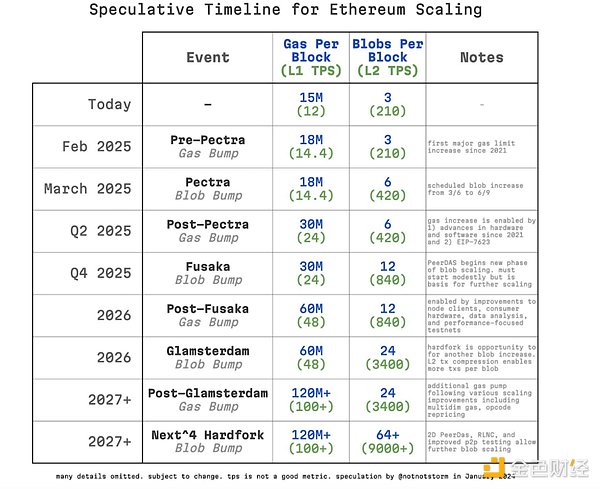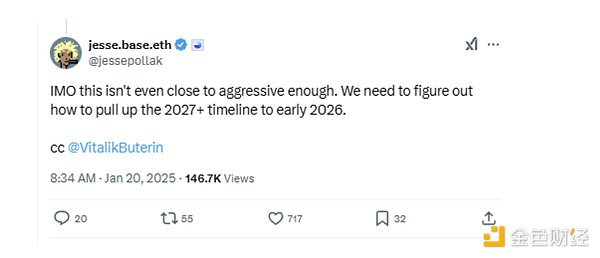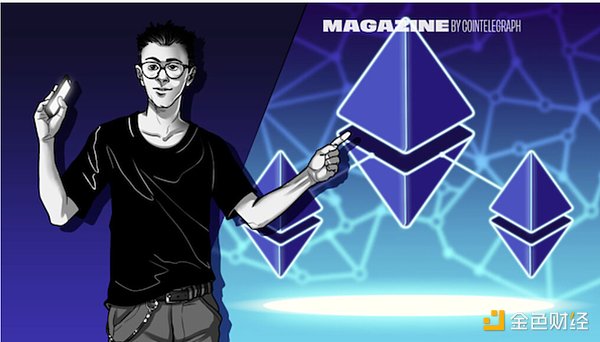Interpreting the PECTRA upgrade can it make Ethereum return to the right track?

Reprinted from jinse
01/30/2025·3MAuthor: Andrew Fenton Source: Cointelegraph Translation: Shan Oba, Golden Finance
Do you feel confused about the PECTRA hard fork explained by the developer? We use ordinary people's language to interpret these upgrades for you.
Recently, Ethereum's expansion roadmap has been criticized by all parties. Even ETH researchers Dankrad Feist and Base founder Jesse Pollak also believed that the existing expansion plan was "lack of ambition" and even "far from being radical enough."
However, the community's questioning seems to ignite the fighting spirit of some core characters .
Last weekend, Vitalik Buterin, the founder of Ethereum, published a new article calling for accelerating the expansion roadmap and raising the current data availability of each block from 3 to 128 or more .
L2 (layer 2) The network relies on Blobs storage data . The more blobs, the lower the growth cost of L2. Therefore, accelerating expansion is essential for the entire Ethereum ecology.
At the same time, Paradigm, an encrypted investment company, also released a proposal , the intention is: "Don't drag it again, and quickly launch the expansion and upgrade!"
On the other hand, L2 leaders such as BASE, Arbitrum and Optimism have also reached consensus that they should uniform ecological standards and adopt a general or native Rollup solution in their respective projects.
So, how much expansion improvement can Ethereum's upcoming PECTRA upgrade (expected to be implemented in March) ? What new features does it introduce to ordinary users? Let's find out.

PECTRA upgrade is divided into two parts
Initially, the PECTRA hard fork plan became the largest upgrade in the history of Ethereum, including up to 20 EIPs (Ethereum improvement proposals) . But now, the upgrade has been split into two parts.
Therefore, PECTRA can only temporarily relieve the problem of expansion . The main improvement is to increase the number of data availability BLOBS from 3 to 6 , which only provides short -term relief for extended demand.
Mallesh Pai, director of the Consensys research , pointed out that "six months ago, the" double Blobs' solution was not even on the roadmap " , but even so, the upgrade still could not meet the growing demand of the L2 network.
"Based on the current growth rate of L2, the effect of this upgrade can only be supported to the end of this summer ." - Mallesh Pai
The good news is that Fusaka hard fork is expected to be implemented later or early next year, which contains a key upgrade:
Peer Data Availability Sampling (Peerdas) -This will become the most important change in Ethereum expansion , and Vitalik Buterin also hopes that the entire community will focus on this.
Peerdas: Blobs version of Torrent
Peerdas is the next evolution of "Proto-Danksharding" technology . It allows L2 to store data in Blobs to avoid competition block space with L1 transactions.
However, the EIP-4844 still requires the complete node to download all Blobs of the entire block and verify the integrity of the data .
" This is extremely inefficient and causes a burden on small node operators. Download Blobs (even if the proposal is required to broadcast Blobs) will consume a lot of bandwidth."
—— Emmanual Awosika (2077 Collective Research Director)
PEERDAS optimizes the method of BLOBS data storage and verification , and divides them into smaller data blocks, similar to P2P seed download (Torrent) , allowing different nodes to store and access some data instead of downloading complete BLOBS.
Vitalik predicts that Peerdas will immediately increase the number of Blobs by 2 to 4 times, and it can reach 8 times or more in the future .
Just last week , the founder of Base Jesse Pollak was also criticizing the existing roadmap of Ethereum to advance slowly, and stated that " the original expansion target in 2027 should be advanced to 2026."
However, if Vitalik 's prediction is correct , Peerdas may increase the number of Blobs to 48/slot in next year , greatly accelerating the expansion process of Ethereum.


However, the improvement brought by the Pectra upgrade is not only double the number of Blobs . AWOSIKA pointed out that there are two key changes:
-
Account abstraction (account abstraction) is suitable for all accounts
-
STAKING LIMIT adjustment
He said that these two changes were "major breakthroughs".
In addition, there is an EIP-7623 highly discussed proposal, which has not yet been determined whether it will be upgraded.
" If the EIP-7623 is eventually implemented, it will be possible to further improve the GAS Limit in the future-this will be a major breakthrough. As for other improvements, it is more optimization and iteration."
—— Emmanual Awosika
The reason why Ethereum's expansion route diagram suffered a lot of empty emotions was largely because:
During the explanation, developers and researchers used a large number of complex terms and technical concepts, resulting in most people unable to understand the actual impact of these upgrades at all.
Therefore, we try our best to translate the key content of PECTRA upgrades into a language that ordinary investors can also understand to help everyone truly understand the meaning of this upgrade.

Everyone has a smart account (EIP 7702)
PECTRA's maximum usability improvement is EIP-7702, which allows the existing Ethereum account to be upgraded to a smart account (also known as "account abstraction").
This will eventually solve the problem of "approval" and "exchange" in the Ethereum transaction that has long been hated by people.
It also supports "social recovery, native multiple signatures, and various other functions, allowing us to bring a lot of new value and experience to users directly," Pai said.
If all of this sounds familiar, it is because as early as 2023, the smart account was launched on Ethereum, and the glorious success of ERC-4337 was achieved. However, this is a method of avoiding hard forks, which requires users to experience the pain process of starting a new wallet. During the peak, about 3.5 million wallets were used.
John Rising of the smart account platform Stackup explained: "Widely used to be hindered by a key limit: users cannot upgrade the existing wallet to a smart account."
It is incredible that PAI said that Buterin proposed a more elegant solution in PECTRA in less than an hour.
"I know he participated in a hunting trip in Kenya at the time, and on a truck […] and came up with a route that everyone could follow and did. So, yes, he was amazing."
Rising said that by allowing the existing wallet to be simply upgraded, "we are eliminating the last main obstacle of mainstream account abstraction."
He said: "We have taken for granted in traditional finance -automatic payment, account recovery, and merchants bear transaction fees -eventually become the standard of web3."
"We will see that we do not need to be approved in advance, gasoline fees paid by any token, biometric safety security that replaces seed phrases, independent agents running safely in the wallet, and seamless cross -chain interactions."
Although all this sounds great, the complex smart account function is relatively expensive on L1. However, once the EIP-7702 is launched on L2, the smart account function can be seamlessly run between the two.

Increased pledge limit for verification (EIP-7251)
For the health of the network itself, a major improvement is to increase the maximum pledge limit of the verified by the verificationist from 32 ETH to 2048 ETH.
At present, if you are fortunate to have 2048 ETH and want to pledge it all, you need to run 64 independent verifications. Considering that the same person control ETH, this will bring 64 times the pressure that the network is in actual needs, and decentralization does not have much benefits.
"The resulting network expenses (each verification person must sign the block, the signature must be summarized, etc.) reduces the performance of the entire network," Pai explained.
AWISOKA said that if millions of verifications try to join the benchmark chain, it will collapse, so it is a wise move. "This has eliminated one of the fundamental reasons for companies such as Lido and Coinbase to run so many verifications without node operators."
There are other benefits to reduce network overhead. "This upgrade has unlocked other urgent upgrades, such as the end of the single slot," AWOSIKA said. Single slot endability allows to propose and complete the block within 12 seconds (rather than 15 minutes), which means that the transaction can almost be confirmed immediately. "SSF is a major obstacle to Rollup's interoperability," he said.
Blob target will double
As mentioned earlier, the Blob target increased from 3 to 6 per block to help L2 expand the scale. The maximum number of BLOB is already 6, but whenever L2 releases the data, the cost will soar, and the L2 becomes not economical.
"It has happened several times this month. PECTRA increased the number of BLOB each block to up to 9, and the average target was 6. Therefore, this was actually increased by 100%." PAI explained.
Having said that, increasing the number of BLOB faster is at the cost of increasing the size of the block, and the higher bandwidth requirements are applied to the Ethereum pledges alone. The higher the request, the less the pledges are separately.
He said: "In the next year, the balance between the needs of Ethereum L2 and its decentralized core value will become the key theme of developers."
In addition, the verifications have always called on raising GAS targets to 36 million per block, which will help expand the basic layer of Ethereum. It does not need a hard fork, and it is likely to be used immediately after the vote reaches 51%.
BLOB may further increase (EIP-7623)
EIP-7623 is considering, but has not been confirmed whether it is applicable to PECTRA upgrade. The proposal can call the data (this is the original method to store data on Ethereum) by reintering pricing (this is the original method of storing data on Ethereum) to increase the number of BLOB each block to 18.
AWOSIKA said: "If they really implement EIP-7623, it is possible to further improve the GAS limit in the future."
The proposal has essentially increased the GAS cost of transactions using a large amount of call data to inspire them to switch to BLOB. This makes the call data and block size predicting, which means that the network can securely increase the number of BLOB without making the system overload.
AWOSIKA explained: "If you can know what the largest block size is (meaning: try to use calling data instead of Blob's rollups will not blow up the block), then I think you can add more blobs "" "
Without the permission to withdraw from Ethereum entrusted pledge
(EIP-7002)
This is another complex upgrade that makes your ETH entrustment more secure. It not only enhances the control of LIDO and Rocketpool to malicious node operators, but also enhances the pledged ETH token holders to obtain the ability of node operators to run the verification device to withdraw funds.
At present, you may encounter a situation that cannot be withdrawn the pledged funds because you have not extracted the required verification key.
"This approach is very bad. The reason is obvious, that is, someone can detain your funds and refuse to agree with the withdrawal," AWOSIKA said.
The new upgrade separates the verification device key used by node operators
from the withdrawal key, which is kept by ETH pledgers. In this way, the
pledker can restore the balance and withdraw money at any time. The pledgers
submitted requests in the form of conventional transactions. After some
technical troubles, "the pledker can withdraw money after the pledged funds
are sent to the withdrawal address without the need to approve the operator."
The upgrade also benefits the pool pledge agreement such as LIDO and
Rocketpool. "At present, node operators funded by DAO's withdrawal address can
refuse to withdraw from the request of the verification device, or
deliberately commit illegal acts to trigger the pledge ETH reduction," AWOSIKA
said.
"Agreement DAO is helpless under the status quo, because these verificationrs can only exit through the verification of node operators. However, the EIP-7002 authorizes DAO to forcibly withdraw from one or more verifications controlled by malicious node operators."

**Extension will not be completed overnight, but it will definitely
happen**
Mallesh Pai believes that the community's hope that expansion and improvement can be more understandable -he is the same.
" Everyone hopes that upgrading can be completed immediately."
" But these improvements will be realized in the end." - PAI
Joe Lubin, the co -founder of Ethereum , said that Ethereum's expansion roadmap is actually much more smooth than many people think .
" I don't think the current progress is absolutely optimal, but I am very satisfied with the current development."
" Although some people think that some aspects are not progressing well, I think the whole is still on the right." -Lubin
Lubin also pointed out that upgrading a market value of $ 400 billion (Ethereum) requires a balance between speed and security . " We must ensure that it does not destroy the network because it carries huge value. At the same time, we also need to ensure that it is still decentralized to users with certain equipment capabilities. Therefore, this is always a trade -off that needs to be discussed."
I personally support the hardware and bandwidth threshold of Ethereum, I think this is reasonable. As for the PECTRA upgrade , Pai believes that it is an important progress that will help solve the problem of long -term trouble in the Ethereum ecology . After PECTRA, the problem that plagues users and developers 'interoperability' and 'fragmented' issues will be easier to solve.


 panewslab
panewslab